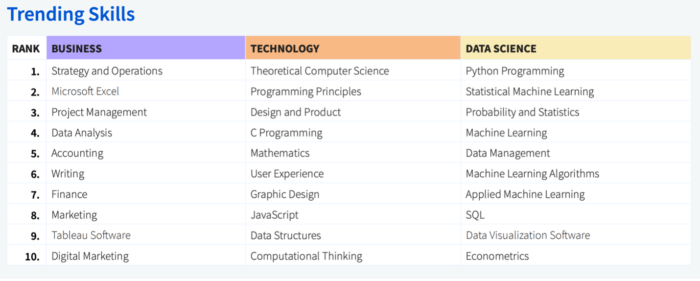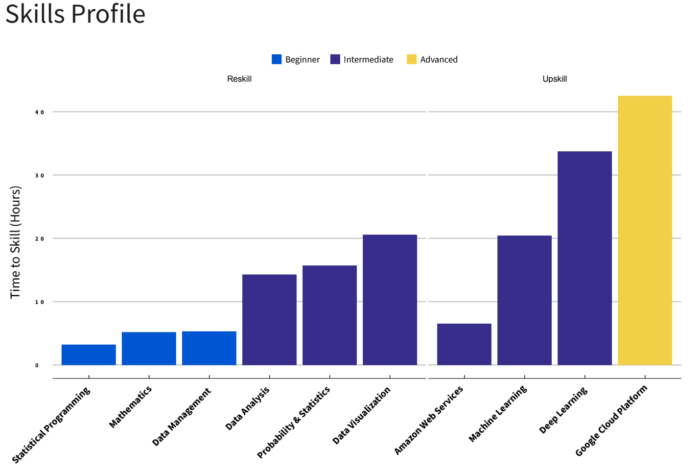
Skills Gap in the U.S. Economy
Coursera, an online learning platform, recently completed a study of the relative skillsets across the globe to identify the economic skills gap. What is the skills gap? It’s the discrepancy that exists in the economy between the preparedness of job seekers and open positions. Let’s explore this issue using the data from Coursera and other researchers to understand what steps workers and businesses can take to improve the efficiency of the job market.
The Skills Gap is Not New
Discussions about the labor market disconnect are not new. In 2018, Industry Week reported that the U.S. skills gap would result in 2.4 million unfulfilled jobs and $2.5 trillion in lost output by 2028. The U.S. Chamber of Commerce Foundation published a 2019 study with additional warnings. They stated, “Our study finds that 74% of hiring managers agree that there is a skills gap in the current labor market, with 48% saying that candidates lack the skills needed to fill open jobs.” The HR professionals interviewed also saw great challenges with the low number of applicants for their roles overall.
Many of the unfilled roles exist in IT departments. At Marchon Partners we’ve written several articles about the demand for IT staff, including in our January 2020 writeup on the tech skills gap as well as our recent 2021 Jobs Update. In our practice, we specialize in sourcing tough-to-find technology skills in fields such as cloud computing, software development, cybersecurity and so much more. Many businesses over the last several years have turned to professional IT staffing companies such as ours to help them fill critical roles to grow their business.
The Digital Economy and The Pandemic Economy Converge
The digital economy existed before the pandemic, but the pandemic economy exacerbated the technology skills gap as companies shifted to remote work, online sales, and low-touch delivery. The pandemic also highlighted the divide in the skilled and unskilled workforce in the U.S. as unemployment skyrocketed in some industries and not others. Many displaced workers are unable to qualify for and fill the jobs that are now available.
As the U.S. emerges from, or at least enters a new phase in, the pandemic, businesses are more eager than ever to fill open job requisitions. As it stands, applications levels remain low and the concern is that, without significant focus on filling the skills gap, productivity loss and stunted economic growth will result.
What Skills Are Employers Looking For?
HR Digest recently reported a list of the top 10 needed jobs. While most of the roles were technology focused, some may be surprised to know that digital marketing/strategy as well as business development did make the list.
Coursera recognizes the demand for business skills as well: Business is one of the three categories, along with Technology and Data Science, that they researched. In their study, they looked at several variables, including class demand, open positions, and Google Search data, to compile a top-10 list of in-demand, or trending, skills.

(coursera.org/global-skills-report, page 40)
Reskilling and Upskilling for Better Opportunity
Two important concepts in hiring and human resources right now are reskilling and upskilling. Reskilling is learning new skills to prepare for a new job or career. Upskilling is upgrading a skillset within a job category to prepare for advancement or to ensure relevancy. The current marketplace is experiencing a deficit of both types: there are not enough candidates with the right skills for open requisitions, and existing employees don’t have the right skills for promotion or to keep pace with the changes in technology for their existing jobs.
Coursera provided a breakdown of foundational skills and advanced skills for different job categories to illustrate the importance of reskilling and upskilling. One example included Data and Artificial Intelligence (AI) roles, with the entry level job title being a Data Analyst. Data and AI jobs have been growing at a rate of over 40% for the past five years and are consistently reported to be in high demand by recruiters.
Coursera identified basic skills required (i.e., reskilling areas) in math and data analysis. The more cutting edge or new skills (i.e., upskilling areas) focus squarely on specific platforms (AWS, Google) as well as developments in AI. See the chart below.

(coursera.org/global-skills-report, page 34)
Using this information, a company could develop a set of hiring and training strategies to help bridge their own skills gap. For new hires, they could focus on individuals with strong core math skills and offer a development path that includes training in the specific platforms and more advanced analytics. For existing employees, leaders could evaluate job preparedness, identify deficits, and build training plans for upskilling. This could help companies retain and advance their best people, and overall, provide their organizations with properly skilled teams.
Are companies willing to foot the bill for employee development? They may have no choice. Certainly, those that can solve their own skills gap challenges will be positioned to grow in 2021 and beyond.
Tags: Labor Participation, skills gap, Unemployment